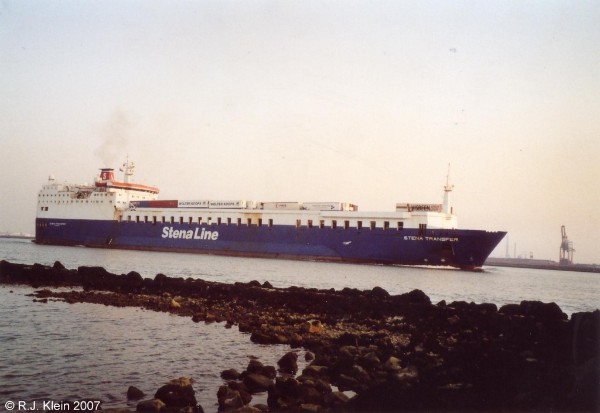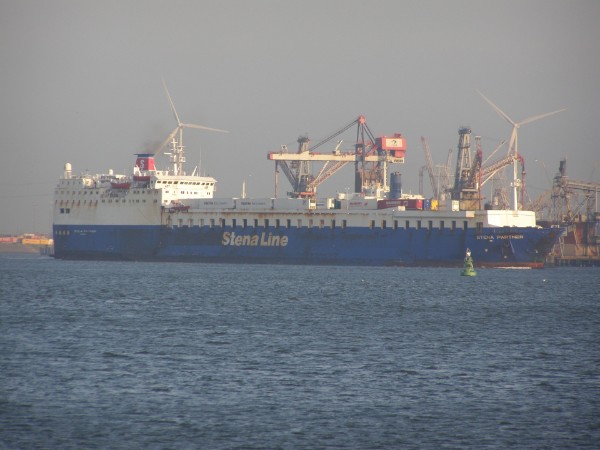Rotterdam Europoort to Harwich
In 1987, the company Townsend-Thoresen was taken over by P&O Ferries, and this sale included the route and the 3 ships of the Rotterdam Europoort to Felixtowe service. Townsend-Thoresen originated from 1968, when the Townsend Car Ferries, a company owned by Monument Securities, merged with the Thorsesen Car Ferries Ltd.. Although the combination was officially named European Ferries Ltd., the ships were marketed under the name of Townsend-Thoresen. European Ferries was also taking over Larne Harbour Ltd, a 50% stake in the former naval dockyard in Harwich and the Felixtowe Dock and Railway Company during the 1970's and 1980's, so the company was also entering the property industry. So European Ferries was a big company that sailed a large routenetwork within western Europe. From Felixtowe, they sailed two route's. One passengerservice to Zeebrugge in Belgium and one freightroute to Rotterdam Europoort.
From 1965 onwards, the financial heavyweight P&O Group had a 'stragetic trade investment' with Monument Securities and thus with European Ferries later on. Everyone expected that P&O would take over the European Ferries business sooner or later, because their property interests, especially in North America, and their large ferry-route network were fitting very well within the strategy of the P&O Group. The deal was finalized at the 19th of january 1987 for a cost of about 345 million pounds. At the end of february, the P&O Group took over management from Townsend-Thoresen. Barely a week later, at the evening of friday the 6th of march, the passengerferry Herald Of Free Enterprise, a part of the Blue Ribbon class and one of the flagships of the fleet, capsized just outside Zeebrugge harbour on route to Dover, with 454 passengers, 80 crewmembers and 131 vehicels on board. It was the biggest peacetime maritime disaster in Great Britain since the sinking of Titanic in april 1912. In total, 155 passengers and 38 crewmembers lost their lives. P&O immidiately responded that the company was responsible for the tragedy and that safety was an all-time first for P&O. But the start with European Ferries under P&O management was a disastrous one.

Stena Transfer when she sailed the route between Hoek van Holland and Harwich for a short while. She is seen here departing Hoek van Holland at the 31st of march 2007. This ship is the former P&O ferry European Tideway, built in 1977.
Because of this, the Townsend-Thoresen ships were quickly rebranded as P&O European Ferries and the Townsend-Thoresen name dissappeared. Also the names of the ships were changed in a new P&O naming system. At the route between Rotterdam Europoort and Felixtowe, the Doric Ferry was renamed European Tideway, the Nordic Ferry was renamed Pride Of Flanders and the Cerdic Ferry was renamed European Freeway. Sometimes these ferries were sailing in charter to other companies or other route's, but this route was the most important for them during their years under P&O management. A small note about the naming, Townsend-Thoresen introduced two new ships for the Dover to Calais service under the names Pride Of Dover and Pride Of Calais prior to the take-over by P&O. So the well-known P&O naming strategy is originally the new naming strategy introduced by Townsend-Thoresen. In 1997, P&O also took over the passengerservice of the Noordzee Veerdiensten/ North Sea Ferries between Rotterdam Europoort and Hull, so their presense in The Netherlands was established firmly.
The freightroute was sold to Stena Line in 2002, after P&O introduced the at that time largest ferries in the world at their Rotterdam Europoort to Hull route. These new giant ferries, Pride Of Rotterdam and Pride Of Hull, were in fact passengerferries built on top of a RORO-freight ferry. By doing so, these ferries could take loads of lorry's together with daypassengers and so it combined the P&O freight and passengerservice in these two ships. Because of that, P&O sold their older and exsisting freightferries and the freightroute between Rotterdam Europoort and Felixtowe to Stena Line. Because of Stena Line's history at the port of Harwich, just at the other side of the water from Felixtowe, the company changed the Euglish port so they could concentrate their operations from one port. Due to capacityproblems and traffic flow at the Hoek van Holland quay, the port in The Netherlands was not changed.

Stena Partner leaving Rotterdam Europoort for Harwich at the 30th of june 2009.
Stena Line used the three original ships from the European Ferries for the service for the time being, although the ships were renamed. European Freeway was, after a short namechange to just Freeway, renamed Stena Partner. European Tideway became Stena Transfer and Pride Of Flanders was renamed Stena Transporter (III). They were originally part of a class of seven freighters, built in 1977 and 1978, so the ships were at the time Stena Line took over the service around 25 years old. They were rebuilt several times and still sailing steadily without problems, but Stena Line wanted to change the route within a few years time. It was to be a route operated by two faster ships instead of three slower ones.
In march 2009, This two-ship service was introduced when Stena Transporter (III) was taken out of service and laid up for sale. She was sold to Stradevlue of Italy, who renamed her Strada Corsa for the route between Livorno and Olbia. She started sailings here from july 2009 onwards. At september 6, 2010, the Stena Transfer was replaced by the Stena Carrier. The Stena Transfer was sold to the Latvian company Finest Sia, based at Riga and renamed Transfer. The ship is currently in lay-up at Göteborg, Sweden. The Stena Carrier is a relatively new ship, launched in october 1998 as Aronte for Stena RORO. It is a true freighter, with a passengercapacity in the cabins of just 12. The Stena Transfer had accomodations for 166 passengers when she was sailing the route. The following december, Stena Partner was sold also, to Partner Sia, based at Göteborg, Sweden. She was renamed Sea Partner and sailed to Tuzla, Turkey for an overhaul. The ship was replaced by the Stena Freighter, a ship that was launched at the 9th of may 1998 as the Sea Chieftain. In 2003, she was renamed Stena Seafreighter, before she got her current name in march 2004. For Stena Line, the ship sailed the Göteborg to Travemünde and Göteburg to Kiel services before she was employed at the Rotterdam Europoort to Harwich service. She also has a passengercapacity of 12, like the Stena Carrier.

